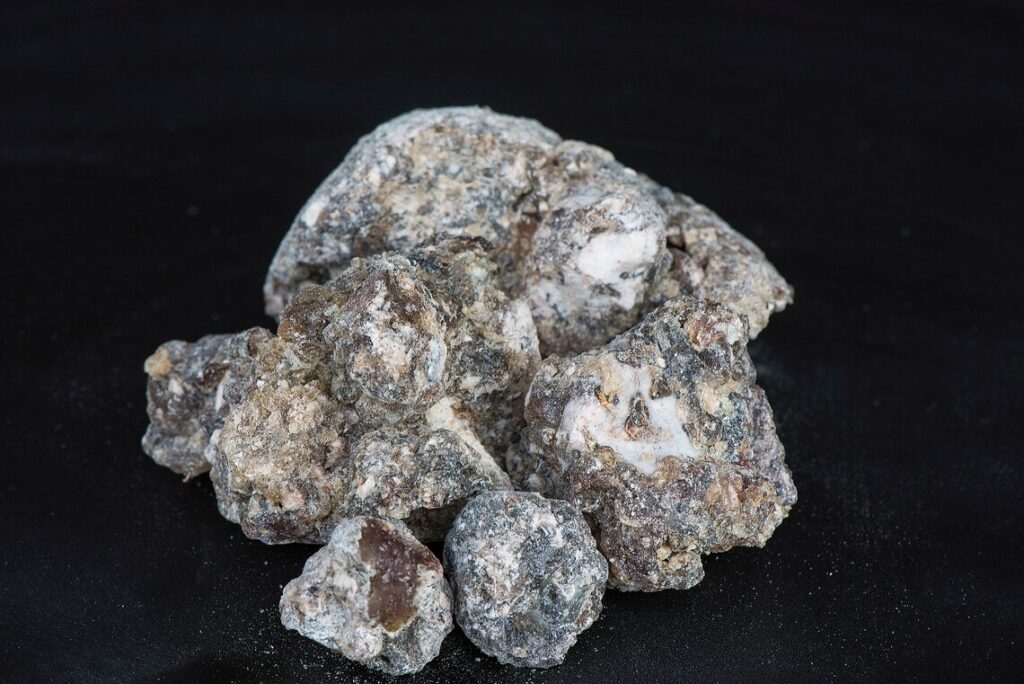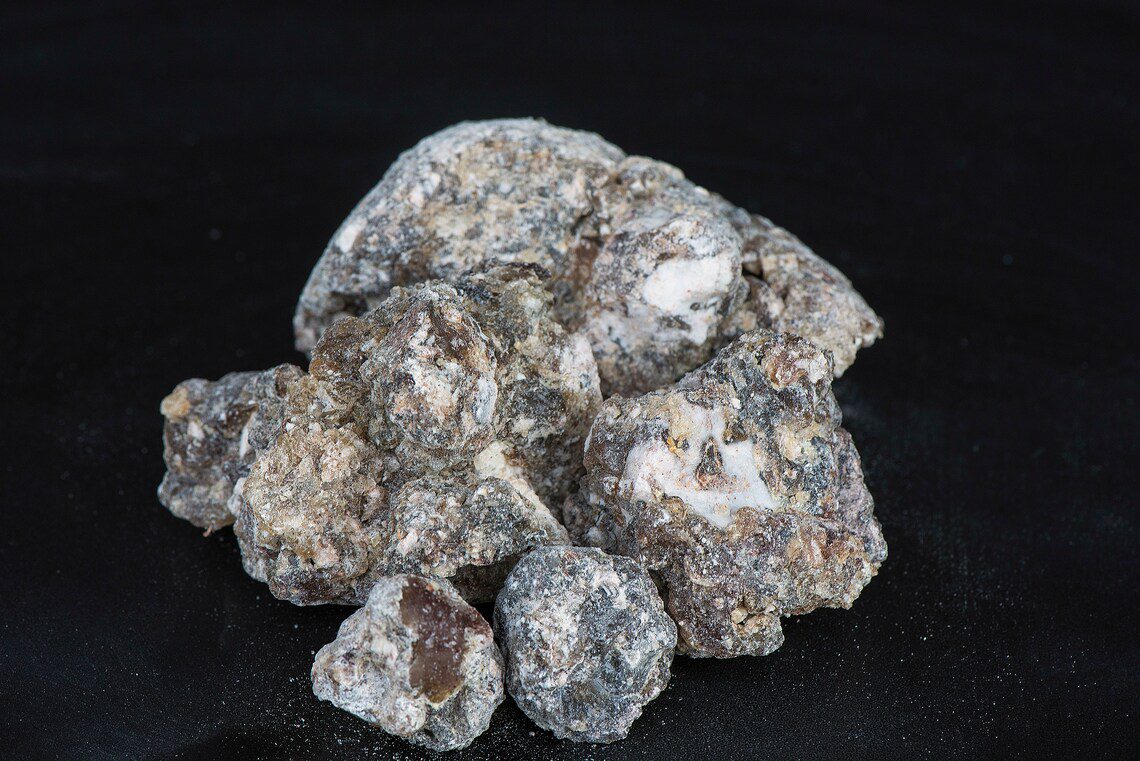Have you ever found yourself captivated by the alluring fragrance of copal? This enigmatic scent possesses a profound ability to evoke emotions and stir something deep within us. Copal incense, an ancient aromatic resin, has captivated minds and hearts for centuries. Its distinct fragrance carries a rich history and cultural significance.
But, what exactly is the fragrance that emanates from this precious resin?
In this blog post, we embark on a sensory journey to uncover the elusive scent of copal and delve into its symbolic meanings. You’ll delve into its diverse applications and uncover the mystical allure that has drawn countless individuals to its aromatic embrace throughout history. Also, unravel the ancient power of copal and how it can liberate the spirit in our modern lives.
What Does Copal Smell Like?

Copal unveils a captivating fragrance profile that combines the sweetness of earthy tones, reminiscent of frankincense, with subtle hints of refreshing citrus notes. This intricate blend creates a clean, light, woody scent akin to the fragrant embrace of pine or the invigorating aroma of turpentine.
Beyond its olfactory allure, the aroma of copal has earned its place in the realms of aromatherapy and meditation, thanks to its inherent calming and soothing properties.
Copal, often likened to amber due to its resinous nature, traces its origins to the Pinus genus. The Central American species of this resin were cherished by ancient Mayans for their use in sacred incense rituals.
Steeped in tradition, copal finds its way into the hearts of those who seek spiritual cleansing, the dispelling of negative energies, purification, and protection. It serves as a potent tool to establish sacred spaces, usher in creativity and abundance, and radiate positive, loving energies.
The Origins of Copal Incense
This aromatic treasure has an illustrious history that spans across civilizations, notably finding its place of honor among the Mayans and Aztecs. But to truly appreciate its significance, we must journey back to its origins in the ancient lands of Mesoamerica.
- Mesoamerica’s Gift to the World:
Copal’s story unfolds in Mesoamerica, a region known for its vibrant tapestry of cultures and civilizations. Here, the resinous sap of certain trees, primarily Protium copal and Bursera species, was revered for its remarkable properties. Copal was not merely a substance; it embodied the divine and the sacred.
- Mayan Marvel:
The Mayan civilization, renowned for its advancements in astronomy, architecture, and mathematics, also held copal in high esteem. To the Mayans, copal was a conduit to the gods, a fragrant offering that bridged the mortal realm with the divine. It was meticulously used in sacred ceremonies and rituals, invoking spiritual connection and seeking divine guidance.
- Aztec Awe:
In the world of the Aztecs, copal was a symbol of purification and protection. Its use extended to myriad rituals, including those dedicated to deities like Huitzilopochtli and Tezcatlipoca. The aromatic smoke of copal was believed to carry messages to the heavens, a powerful means of communication with the divine.
- Revered and Reincarnated:
The reverence for copal was not limited to ancient times. Its sacred legacy endures, still being employed in contemporary rituals by indigenous peoples of Mexico and Central America. Copal’s significance transcends generations, a testament to its enduring power.
Uses of Copal
Copal, a precious tree resin, holds a sacred place in the world of incense, serving as a vessel for a multitude of spiritual and cultural practices. Its uses extend far beyond mere fragrance:
- Strengthen spiritual connection
- Clear negative energy
- Purify and protect
- Create sacred spaces
- Invite creativity, abundance, and positive loving energy
- Open to the soul, intuition, and inspiration
- Feed the soul of the deceased
- Say thank you to ancestors
This revered resin continues to be a significant part of the cultural and spiritual heritage of indigenous peoples in Mexico and Central America. In Mexico, it maintains its association with spiritual and medicinal connections, carrying forward the wisdom of generations past.
The Aroma of Copal
Describing the scent of copal is akin to capturing the essence of mystery itself.
- A Symphony of Scents
Copal unveils itself in a warm and resinous embrace that envelops your senses. As you inhale, you’ll detect the delicate interplay of nature’s finest fragrances.
- Citrus Zest:
Delve deeper, and you’ll uncover subtle hints of citrus, like rays of sunshine piercing through the forest canopy. These citrusy notes add a zesty, invigorating dimension to the copal’s aroma.
- Pine’s Embrace:
Yet, copal is more than just citrus. It shares a kinship with evergreen forests, with the aroma of fresh pine needles and the crisp air that accompanies them. It’s as if you’re wandering through a tranquil forest grove.
- Earthy Whispers:
Beneath it all lie earthy undertones, grounding the experience. These notes evoke images of rich, fertile soil and the ancient wisdom that resides within it.
- Sweet Balsamic Harmony:
But perhaps what truly sets Copal apart are the sweet, balsamic notes that dance through the fragrance. These notes add a harmonious sweetness, akin to the embrace of a beloved friend.
- A Captivating Journey:
Inhaling copal is like embarking on a sensory expedition, where every breath reveals a new facet of its enchanting character. It’s a fragrance that transcends mere words, immersing you in a world of timeless wonder and spiritual connection.
Symbolism and Spiritual Significance
Copal incense carries profound symbolism across various cultures. It is often associated with purification, spiritual cleansing, and communication with the divine. The smoke rising from the burning copal is believed to carry prayers and intentions to the spiritual realm.
- A Tapestry of Symbolism:
Copal incense, like a sacred thread, weaves its way through the tapestry of diverse cultures, carrying profound symbolism and spiritual significance. It serves as a bridge between the earthly and the divine, representing purity, transformation, and communion with the spiritual realm.
- Purification and Spiritual Cleansing:
One of the copal’s primary symbolic roles is that of a purifier. Its fragrant smoke is seen as a cleansing agent, capable of dispelling negative energies and restoring spiritual clarity. The act of burning copal becomes a ritual of renewal, washing away impurities and inviting in the sacred.
- Messenger to the Divine:
As the resin transforms into fragrant smoke, it becomes a messenger, carrying prayers and intentions heavenward. The rising smoke is believed to transcend the physical realm, carrying with it the hopes, dreams, and supplications of those who burn it. This ethereal connection allows for a profound communion with the divine.
- Protection and Blessings:
Copal is also a guardian, shielding against malevolent forces and unwanted influences. Its presence in rituals and ceremonies is a testament to its protective qualities. By enveloping spaces and individuals in its fragrant embrace, copal acts as a shield against negativity.
- A Universal Language:
While the specific symbolism may vary from culture to culture, the universal language of copal is that of reverence and spiritual connection. It’s a reminder that, across time and geography, humanity has sought to touch the divine and cleanse the spirit, finding solace and meaning in the aromatic tendrils of copal incense.
Wrapping Up
The enigmatic scent of copal incense carries with it the echoes of centuries past, serving as a fragrant bridge between the present and ancient traditions. Its captivating aroma, steeped in cultural symbolism, beckons us to embark on a spiritual odyssey. Whether employed for purification, meditation, or simply to luxuriate in its aromatic embrace, copal incense stands as a treasured relic, a testament to the enduring legacy of our shared human experience. In its fragrant tendrils, we find a timeless connection to the rituals, beliefs, and aspirations of generations long gone, and a reminder that, in the world of scents, copal is a fragrant vessel that continues to unite us with the mysteries of our past.
Frequently Asked Question
How Long Does Copal Last?
Copal’s earthy, sweet aroma can last for years, depending on the type and form. It can range from several months to several years. Various forms include incense sticks, resins, and oils, all capable of creating a peaceful ambiance.
What Is The Best Way To Store Copal?
To preserve the copal’s scent, store it in an airtight container, wrapped in a cloth pouch, in a dry and cool area like a cupboard or shelf. Proper storage ensures its intoxicating aroma lasts for many years.
How Do You Burn Copal?
Burning copal requires an appropriate burner or container and a means to light it. A wide-surface burner is best for a slow, steady burn. Place copal pieces on the burner and ignite them with incense sticks or charcoal tablets, while keeping a watchful eye to prevent accidents.
What Is The Best Way To Clean Copal?
To maintain copal’s scent and longevity, gently brush off dirt or debris with a soft-bristled brush. Waft smoke from a smoldering incense stick over the copal to refresh its scent while cleaning and purifying it.
Does Copal Have An Expiration Date?
Copal doesn’t have an expiration date; it can last for centuries. This naturally occurring tree-based resin is durable and long-lasting, provided it’s stored correctly. Proper storage ensures it remains aromatic and usable for many years to come.











